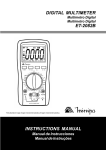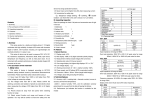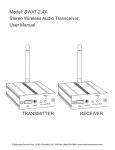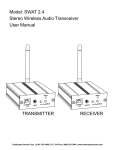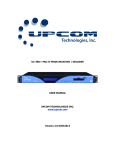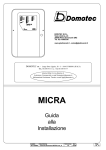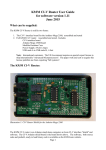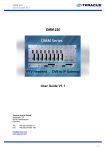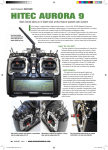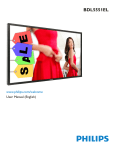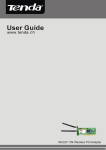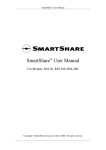Download Williams Sound Digi-Wave white paper
Transcript
Digi-Wave™ Technology Williams Sound Digi-Wave™ White Paper TECHNICAL DESCRIPTION Operating Frequency: The Digi-Wave System operates on the 2.4GHz Industrial, Scientific, and Medical (ISM) Band, which is intended for short-range, low power applications. The unlicensed ISM band is harmonized for use in most countries, however, users should always check with local radio regulations to be sure of legal operation. The most commonly encountered devices that also operate in this band are 2.4GHz 802.11b WiFi routers and Bluetooth devices. Other users are microwave ovens, Electro-Discharge Machines (EDM) machines, and some medical diagnostic equipment. Frequency-Hopping Spread Spectrum: Digi-Wave utilizes Frequency-Hopping Spread Spectrum (FHSS) to minimize interference with other wireless services operating in the same band. FHSS is a method of wireless transmission that rapidly switches a radio carrier over a number of different frequencies in a pseudo-random sequence instead of on a single, fixed frequency. By using many frequencies in the same band, the signal is “spread” over the entire band. The 2.4 GHz ISM band is sufficiently large to allow efficient spread spectrum operation. In order for a frequency-hopping system to work, the hopping sequence must be followed by both transmitter and receiver, a process called synchronization. FHSS has several advantages over fixed frequency transmission: 1. Because the signal only stays briefly on each frequency, this reduces the probability of landing on the same frequency at the same time as another service, referred to as a “collision.” This gives strong resistance to narrowband interference on a single channel because the system is continually hopping around it. The spread spectrum signal likewise adds minimal noise to other narrow-band transmissions because of the short time interval spent on each channel. 2. Spread spectrum signals are difficult to intercept. Unlike a fixed-frequency system, where only one frequency needs to be known by an eavesdropper, the pseudo-random sequence of frequencies would need to be known. 3. Spread spectrum allows more users to share the same spectrum, since within limits, they will be hopping onto different frequencies at different times, reducing the likelihood of interference. 4. Spread spectrum signals are also resistant to multipath fading. Since the signal constantly changes frequency, the wavelength also constantly changes, thus the relationships between direct and reflected signals that cause cancellations are also changing. FHSS Channelization: A Digi-Wave channel is represented by a 4 frequency sequence, hopping through 16 center-frequency channels between 2.402 and 2.476 GHz at a rate of 325 hops per second. The channel is divided into time slots of approximately 3 milliseconds, where each time slot corresponds to a hop frequency. The hopping sequence is pseudo-random since it follows a carefully selected fixed table of channel sequences. For security reasons, the hopping sequence algorithm is proprietary. There are four separate channel sequences used when Digi-Wave is operated in the two-way mode and 8 sequences used when Digi-Wave is operated in the Interpretation mode. Channel separation is 2000kHz in Two-Way mode and 5000kHz in Interpretation mode. TCH 004A Digital Modulation: Digi-Wave makes use of Gaussian Frequency-Shift Keying (GFSK) modulation. Frequency-Shift Keying (FSK) is a type of frequency modulation in which digital information (binary 1’s and 0’s) is transmitted through frequency changes in a carrier wave. GFSK uses a Gaussian filter to smooth and limit the positive and negative frequency changes or pulses. This pulse-shaping reduces the total bandwidth used. GFSK is also used in DECT and Bluetooth applications. Multiple Access or Channel Sharing: Digi-Wave uses synchronous Code Division Multiple Access, (CDMA) an encoding process which allows multiple users to simultaneously share the same channels. Each Master transmitter is assigned a unique 64-bit group code. The group code allows transmitters and receivers to identify each other. Only transmitters and receivers sharing the same code can communicate with each other. Codes from other groups are not recognized and are ignored. In addition, CDMA is a frequency-hopping technique. The transmitter and receiver use fixed tables of channel sequences so they can maintain synchronization by following the table. The transmitter periodically sends its current location in the table, allowing the receivers to stay in step. Orthogonal sequences are used, because they do not interfere with each other. Orthogonal describes the mathematical relationships between the sequences where cross-correlation equals zero. The group code is also called the spreading code. By spreading the data over the frequency-hopping signal, the coded signal has a much higher data bandwidth than the original data being sent. This is referred to as spread spectrum process gain, which adds data redundancy to reduce errors, and is equivalent to increased signal power. As an additional benefit, a synchronous CDMA receiver can in theory completely reject strong signals using different codes due to the orthogonal relationship of the signals. Signals with a different code appear as wideband noise, reduced by the process gain. Once the data signal is encoded by the CDMA process, the radio signal containing both the data and the frequency-hopping instruction is transmitted using Time Division Multiple Access (TDMA). TDMA divides the band access up into blocks of time. Each user takes turns sending their data, allowing more users in the same bandwidth. Latency: All digital audio systems exhibit latency – a delay due to the time required to convert the original analog audio signal into a digital signal, modulate it, transmit it, and convert it back into an analog audio signal. Digi-Wave technology provides an excellent lowlatency time of less than 7 milliseconds, important for real-time, voice applications. This is substantially lower than the 25 to 40 millisecond latency for Bluetooth transmission, which introduces a noticeable delay from the source in live audio applications. Transmit Power: Digi-Wave Effective Isotropic Radiated Power (e.i. r.p.) is limited to 20 dBm (100mW), the same as a Class 1 Bluetooth device. Isotropic refers to distributing power equally in all directions. Typical output is 14dBm. Note: Power output is limited to 10dBm in France. Encryption: The Digi-Wave system uses 87-bit encryption, consisting of a 64 bit group code, a 16-bit security code, and a 7-bit scan code. As an additional privacy measure, the DLT 100 Transceiver features an optional, 4-digit Secure Key Code (PIN) that can be set to create a specific group of DLT 100’s that will only work together. DLR 50 and DLR 60 Receivers do not have Key Code capability. Privacy vs. security: The Digi-Wave system is designed to offer a high degree of privacy in commercial communications applications. The system encoding does not support secure military or intelligence-gathering applications. As a practical matter, with 1024 possible group codes and 10,000 possible Key Code combinations, it is likely that a communication would be finished long before a “brute force,” trial and error cracking attempt could be made. Using the Digi-Wave System Number of Users: The Digi-Wave system allows one-to-one and one-to-group communication, as well as intra-group communication. An unlimited number of DLR50 or DLR60 Receivers can be used with a corresponding DLT 100 Transceiver. A Transceiver transmits and receives, so is capable of two-way operation. Up to 1024 DLT 100 transceivers may be used together in the same group. When DLT100’s transceivers and DLR 50/DLR60’s receivers are used together, up to 1024 DLT’s can be used with any number of DLR’s. (Group number chosen should be between 0 -99) Address Codes: Each DLT 100 has a 4-digit Address code (0-1023), which is entered in the set-up mode. Each DLT 100 within a group should have a unique address. DLR50 and DLR60 receivers do not have a settable address code. If the Voting function is used, the system only recognizes devices with address codes from 0 to 99 (up to 100 users). Groups: A group code determines which DLT and DLR Digi-Wave units can work together and forms the first level of system security. Units that have the same group code, 10 for example, will work together. Units set to a different group number will not work together. If only DLT 100’s are used, each unit is programmed with a 4-digit Group code (0 – 1023). If DLR 50/DLR 60 Receivers are being used, Group codes must be between 0 and 99. Up to four separate groups, each using a different group number, can operate simultaneously in the same place at the same time. For best results, consecutive group numbers (12, 13, 14, 15) should be used. Adding more groups will increase the likelihood of signal collisions and loss of signal. More than 4 groups can be used if there is a physical separation of 15m (50 ft.) or more between the groups, due to the “capture effect” which causes receivers to pick up the closest, strongest signal. Secure Key Code (PIN): As an additional security measure, the DLT 100 Transceiver features an optional, 4-digit Secure Key Code that can be set to create a specific group of DLT 100’s that will only work together. For example, if six DLT 100’s are set with a Secure Key Code of 1234, only those six units will work together. The DLR50 and DLR60 receivers do not have the Key Code feature. These receivers cannot be used with DLT100’s that have a PIN code set. Operating Distance: Operating distance is highly dependent on environmental conditions. Under ideal conditions, with line of sight and no other 2.4GHz services present, operating distance can be up to 100m (328 ft.). Under poor conditions, with many 2.4GHz services present, operating distance can be reduced to 10 to 15m (30-40 ft.) Note: Output power is limited to 10dBm in France, therefore operating distance is reduced by 40%. Indoor Use vs. Outdoor Use There is no restriction for indoor or outdoor use. In general, operating distance is greater when the system is used indoors than when used outdoors or in large, open spaces. Indoor range is generally greater due to reflections (multipath) as the radio signal bounces off of walls, floors, and ceilings. The reflected signals can help overcome body shielding and high frequency propagation losses. The rapidly hopping frequency also helps to overcome signal loss due to frequency cancellations. Body shielding The human body is an effective shield at 2.4GHz frequencies. If the Digi-Wave units are worn such that users are facing each other with the Digi-Wave units facing each other, operating distance will be maximized. If the Digi-Wave units are worn such that users are facing away from each other and the user’s bodies stand between the units, range will be minimized. The low-power RF signal produced by the Digi-Wave transmitter is not known to pose any health risks. Digi-Wave Antennas: Digi-Wave Transceivers and Receivers do not have external antennas. Due to the high frequencies used, the wavelength is very short, (12.5cm or 4.92 in.) which allows the transmit/receive antennas to be built inside the products. The antennas are optimized with an elliptical output pattern. In general, maximum system range is achieved when all units are held vertically, matching antenna polarization. Increasing Distance with Repeaters: In Interpretation mode, additional DLT 100’s can be configured as Repeaters, increasing system range by 50% (150m or 490 ft.). This requires one Master DLT 100 and one Repeater DLT 100 per language channel used. Resistance to Interference: Received Interference: All radio systems are potentially subject to interference. Digi-Wave is designed to minimize the likelihood of interference, but cannot completely eliminate the possibility. What is typically seen with Digi-Wave in the presence of many WiFi signals is a reduction in system range, but not a loss of signal. For example, an extreme situation is demonstrating the product at a major trade show where in excess of 20 WiFi networks are in simultaneous operation. The DW system continues to function in this environment, without loss of voice data, but operating distance drops from more than 30m (100ft.) to 10m (30 ft.) Microwave ovens and Electro-Discharge Machines operate at 2.4GHz and can create strong interference if the Digi-wave system is used in close proximity (within 1m or 4 ft.) In general, other services operating in the 2.4GHz band will not directly interfere with the Digi-Wave system, but may reduce the system range if the interference is strong enough. Transmitted Interference: The Digi-Wave system generally does not cause interference to WiFi networks and other 2.4GHz services. The CDMA frequencyhopping operation does not disrupt WiFi transmission. Network throughput may be impacted if the Digi-Wave unit is operated in close proximity to a WiFi router (within 1m or 4 ft.) Interpretation Mode vs. Two-Way Mode The Digi-Wave can be programmed into one of two basic operating modes. Please refer to the User Manual for programming and set-up details. Interpretation Mode: In the interpretation mode, the DLT 100 units are set up as one-way transmitters, each assigned to a separate channel. Each Interpreter uses a DLT 100 to transmit their voice to the audience. A Master DLT100 is set to Channel 0 and synchronizes all of the other DLT 100 units, while providing an audio feed of the original message (Floor) to the interpreters. All interpreter units must be within range of the Master unit. The system will support the Floor plus up to 14 languages. The audience members use a DLR 50 or DLR 60 Receiver, selecting the channel to hear the language they understand. Any number of receivers can be used. Two-Way Mode: In the two-way mode, the system can be used for one-way or two-way communication. Two-way communication is only possible from DLT 100 Transceiver to DLT 100 Transceiver. Users activate their talk signal by pressing the Talk button. Any two DLT 100’s can be active at the same time for two-way conversation. The Master unit always has talk priority. Talk status hands-off when another user presses their Talk button. There is no queueing. Up to 1024 DLT 100’s can be used in this configuration. If the voting feature is used, the system is limited to 100 DLT 100 units. DLR 50 and DLR 60 Receivers are receive only units. They do not have a Talk function. When DLR50/DLR 60 Receivers are used, up to 100 DLT 100’s can be used in the same group. Two-Channel Reception: The Digi-Wave system incorporates two receiver channels in each unit. This allows two DLT100 units in the same group to transmit audio simultaneously. Receivers pick up both channels and mix the audio together. This unique design facilitates team teaching, team tour guiding, team presenting, and sequential interpretation. Digi-Wave Approvals: FCC, Industrie Canada, C-Tick CE, (Complies with ETSI EN 300 328 V1.7.1), ROHS2, WEEE 10300 Valley View Rd • Eden Prairie, MN 55344 800-328-6190 / 952-943-2252 • FAX: 952-943-2174 www.williamssound.com ©2013 Williams Sound • All Rights Reserved TCH 004A






